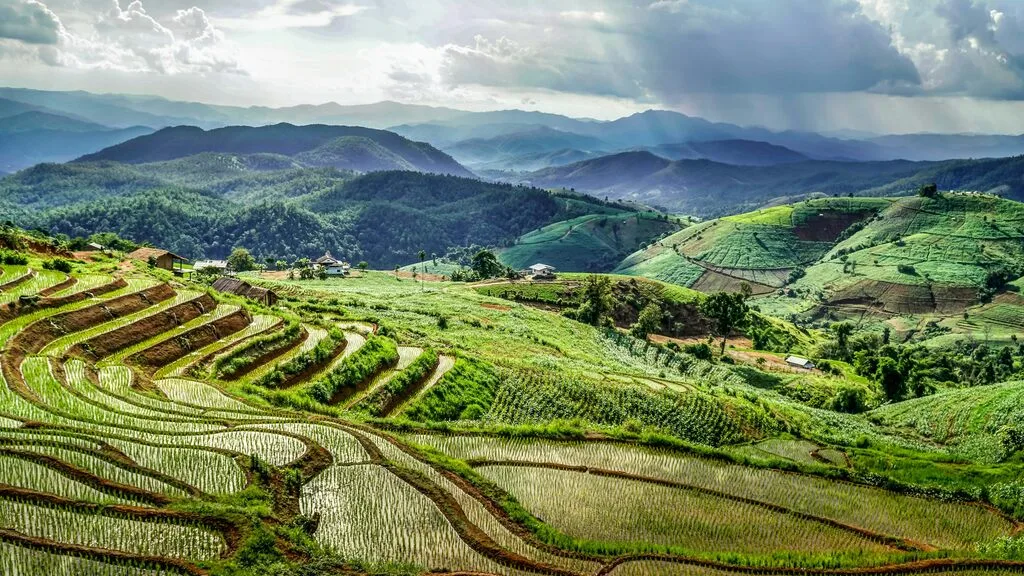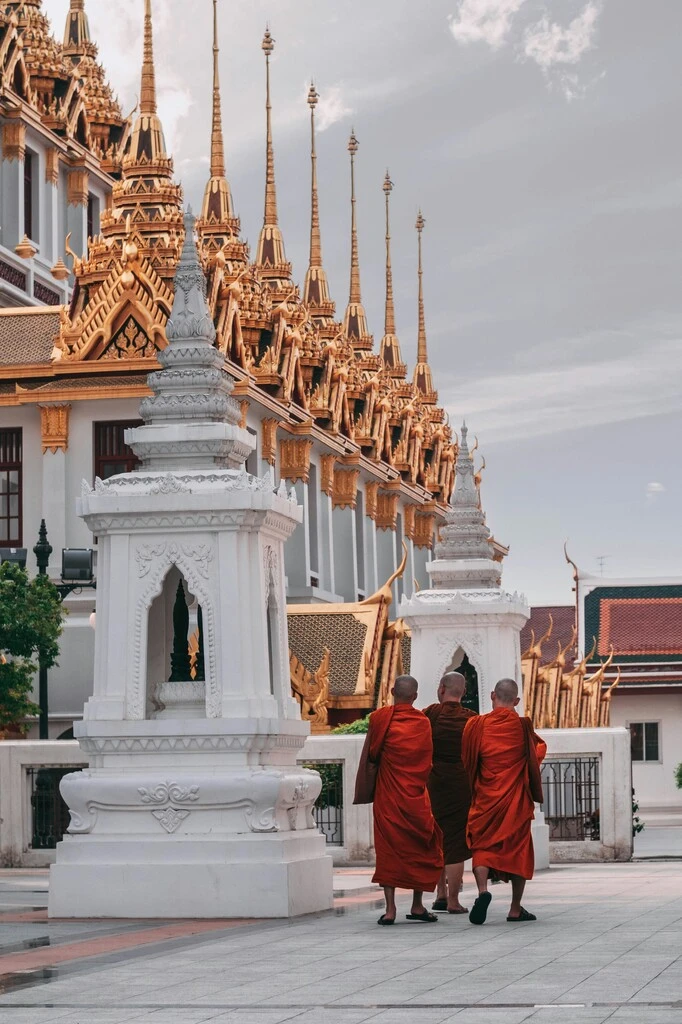Planning a trip to Thailand but not sure when to go? You’re in the right place!
I’ve been living in Thailand with my family since 2019 and have experienced every kind of weather. We’ve lived in the north (Bangkok and Chiang Mai), Thailand’s west coast (Phuket), and the east (Koh Phangan, Samui, and Koh Tao).
We’ve seen it all—floods, extreme heatwaves, and perfect beach days with a gentle breeze.
In this article, I’ll walk you through the best months to visit Thailand, depending on where you’re headed.
By the end, you’ll know exactly what to expect and when to come.

Best Months to Visit Thailand by Season: Understanding Thailand’s Climate
To understand the best months to visit Thailand, you need to know how the country’s tropical climate works. Thailand has three main seasons: cool and dry, hot, and rainy.
Temperatures remain warm year-round, but rainfall and humidity levels vary significantly depending on the time of year and region.
Cool and Dry Season (November to February, or Mid-December to March in the Gulf of Thailand)
During this time, the weather cools down a bit. Daytime temperatures sit around 77-90°F (25-32°C), but up north in places like Chiang Mai and Pai, nights can drop to 50°F (10°C) or even lower in the mountains.
Rain is scarce, especially in December and January, when some spots get less than 0.4 inches (10 mm) of rain. Down south, along the Andaman Sea (Phuket, Krabi, Koh Lanta), expect warm waters, and a calm sea. Overall, the weather is nice and steady.
Humidity levels drop to 50-60% in central and northern Thailand, making the air feel more comfortable. Winds are usually mild, though higher elevations can get a bit gusty.
The Gulf of Thailand (Koh Samui, Koh Phangan, Koh Tao) has a different rhythm. While most of Thailand dries up in November, these islands tend to stay rainy until mid or late December.
Their dry season kicks in from mid-December to March, bringing clear skies and lower humidity.
Hot Season (March to May)
While not typically considered among the best months to visit Thailand, the hot season still has its perks—especially for those who love beach days and fewer crowds.
The hot season cranks up the heat, with temperatures soaring to 95-104°F (35-40°C) in central and northern Thailand. Bangkok often hits 100°F (38°C), and places like Ayutthaya and Sukhothai can reach a scorching 105°F (40°C) in April.
Coastal areas stay a little cooler thanks to sea breezes, but it’s still plenty hot.
Rain is still pretty rare early in the season, with 1.2-2 inches (30-50 mm) falling per month, mostly in quick but intense showers.
By late May, humidity climbs past 70%, making everything feel even warmer.
The sun is relentless, with UV levels reaching 10-12, which is considered extreme.
Heatwaves are common, particularly in inland areas, and urban environments like Bangkok can experience the urban heat island effect, making it feel even hotter.
Rainy Season (May to October, or September to December in the Gulf of Thailand)
Thailand’s monsoon season brings plenty of rain, but how much depends on where you are. Rainfall ranges from 5 inches (125 mm) in May to 12-14 inches (300-350 mm) in September and October, making these the wettest months.
Storms usually come in short, heavy bursts, lasting 1-2 hours, often in the late afternoon or evening. But in September, downpours can stick around longer, sometimes causing flooding in cities like Bangkok and Chiang Mai.
Expect high humidity, often over 80%, and temperatures that range from 77-95°F (25-35°C). Along the Andaman Coast (Phuket, Krabi, Koh Lanta, Koh Phi Phi), rough seas and strong winds can sometimes make ferry travel tricky.
The Gulf of Thailand (Koh Samui, Koh Phangan, Koh Tao) has a different rainy pattern. While most of Thailand sees heavy rain from May to October, these islands stay drier during that time.
Instead, their rainy season starts later—around September and lasts until late December, with November being the wettest month.
Thailand’s rainy season is driven by two monsoons:
- Southwest Monsoon (May–October): Brings moisture from the Indian Ocean, affecting most of the country.
- Northeast Monsoon (November–March): Hits the Gulf of Thailand, bringing heavy rain to Koh Samui, Koh Phangan, and Koh Tao, while other areas start drying up.
As you can see, Thailand’s weather isn’t the same everywhere. Up north and in central Thailand, temperatures change more throughout the year, while the coastal and southern areas stay warm and humid pretty much all the time.

When is the Perfect Time to Visit Thailand?
Well, as you can see from the seasonal differences above, the best months to visit Thailand depend on where you’re going.
That said, November to early April is ideal for most travelers. The temperatures are pleasant, nature is lush and green after the rainy season, and the whole country feels alive again.
But keep in mind—this is also peak season. Prices are at their highest, and tourists are everywhere. That’s just the price you pay for the best weather, right?!
A Month-by-Month Guide to Thailand’s Weather
Let’s break down the best months to visit Thailand month by month, so you can choose the ideal time for your trip.
January – Perfect Weather, But Peak Season
January is one of the best months to visit Thailand, sitting right in the middle of the cool season.
No matter where you go—north, south, Andaman Coast, or the Gulf of Thailand—you can expect pleasant temperatures, low humidity, and very little rain.
Most days bring 8-11 hours of sunshine.
In Chiang Mai and Pai, it can get surprisingly chilly, especially at night. If you’re heading to the mountains, bring a sweater for the evenings.
No surprise, January is one of the absolute best months to visit Thailand—but that also means high prices and crowds. The time around Christmas, New Year’s Eve, and the first two weeks of January is the most expensive of the year.
Hotels are booked out fast, and you’ll find big crowds in popular spots.
February – Still Cool, Still Busy
February is pretty much the same as January, with fantastic weather all over the country. The only difference? Even less chance of rain.
Tourists are still everywhere, and prices are still high, but slightly lower than in January.

March – The Start of Shoulder Season
March is when the cool season starts to fade. I love this month because the weather is still perfect—blue skies, temperatures under 32°C (90°F), and almost no rain.
Best part? Mid-March is the start of shoulder season. Prices start to drop, and the number of tourists decreases.
⚠️ Warning: Chiang Mai and northern Thailand enter burning season. Farmers burn crops, and the air becomes dangerously polluted.
Schools close, and many locals escape to the south. If you have asthma or are sensitive to air pollution, avoid Chiang Mai between February and mid-April.
Side note: We once lived in Chiang Mai until mid-January, and we already had trouble breathing. We had to run an air purifier 24/7!
April – Hot, But Manageable
April marks the official start of Thailand’s hot season. Expect intense heat, with some days reaching 40°C (104°F) in Koh Phangan.
But here’s the thing—if you plan your day right, it’s totally manageable. Spend the hottest hours indoors, take it slow, and you’ll be fine.
Fewer tourists, lower prices—and best of all? Songkran! Thailand’s biggest and most fun festival happens in April. More on that later.
May – Still Hot, But Less Crowded
May is a lot like April. The heat is intense, and tourists are disappearing. Prices continue to drop, but nature is starting to dry out. Even lush jungles look a bit faded by now.
June – Rainy Season Begins (But It’s Not That Bad)
By June, the rainy season starts in northern and western Thailand. Honestly, after months of heat, the rain feels like a relief.
At first, it’s not too bad—just short afternoon showers that cool things down. The Gulf of Thailand (Koh Phangan, Samui, Koh Tao) stays mostly dry, while Chiang Mai and Phuket get more rain.
July – More Rain, Fewer Tourists
July is similar to June, but the rainy season picks up. Expect more frequent showers, especially in the afternoons.
The good news? It’s low season for tourists. That means quieter beaches, fewer crowds, and better deals on hotels.
August – Unexpectedly Busy
For some reason, August is a mini-high season. Even though it rains a lot, tourists suddenly flood the Gulf islands, and prices rise again.
I think it’s because of school holidays worldwide—families want to travel, no matter the weather.
Personally? I don’t recommend visiting in August. You’ll pay more, but the weather won’t be better.
September – Peak Monsoon Season
September is Thailand’s rainiest month. In Phuket and northern Thailand, the monsoon is at its worst. I wouldn’t recommend a beach holiday on the Andaman Coast now.
But in Koh Phangan, Koh Samui, and Koh Tao, the rain isn’t as bad, and you’ll still get some dry days.
The upside? It’s shoulder season again. August’s mini-high season is over, and prices have dropped. If you don’t mind some rain, it’s a great time to visit the Gulf islands.
October – Perfect for Northern Thailand
October is the best time to visit Chiang Mai and northern Thailand. The rainy season is almost over, the landscape is lush and green, and high season hasn’t started yet.
But on the Andaman Coast (Phuket) and the Gulf islands, there’s still heavy rain. If you’re planning a beach holiday, wait a little longer.
Many expats from Koh Phangan escape to the north at this time.

November – A Transition Month
November is a fantastic month for northern Thailand and the Andaman Coast. The rain slows down, and the weather is cool and fresh.
But avoid Koh Phangan, Koh Samui, and Koh Tao. This is the worst part of monsoon season in the Gulf of Thailand.
Heavy rains and flooding can be serious. In November 2024, parts of Koh Phangan were completely underwater, and people had to be evacuated.
December – High Season Begins
December marks the start of high season across Thailand.
The Andaman Coast (Phuket, Krabi, Koh Lanta) is dry and sunny weather, but the rainy season lasts until Christmas.
In the rest of Thailand, it’s perfect weather—plenty of sunshine, comfortable temperatures around 28°C (82°F), and low humidity.
But prices start to rise, and by Christmas and New Year’s Eve, they peak. If you want to visit in December, book early!
Local Festivals and Events
I already mentioned it earlier—Thailand has some incredible celebrations that are worth planning your trip around. Here are my favorites.
Songkran (April) – Thailand’s Giant Water Fight
Thailand’s New Year celebration is basically a country-wide water fight. For three days (or more, depending on where you are), people take to the streets with water guns, buckets, and hoses, soaking anyone and everyone.
It’s loud, messy, and incredibly fun—but also has deep cultural roots. Traditionally, water was used to bless elders and cleanse bad luck before the new year.
Now, it’s evolved into one of the world’s most exciting festivals.
Best places to experience it? Bangkok’s Khao San Road, Chiang Mai’s Old City, and Phuket’s Patong Beach (even though this felt more like a water war than anything else the last time I experienced Songkran in Phuket).
Loy Krathong (November) – The Festival of Lights
One of Thailand’s most magical nights. During Loy Krathong, people release small, beautifully decorated floats (krathongs) onto rivers, lakes, and ponds to thank the water goddess and let go of bad luck. It’s all about renewal, reflection, and starting fresh.
Meanwhile, in the north—especially in Chiang Mai—Yi Peng Festival happens at the same time. Instead of floating krathongs on water, thousands of lanterns are released into the sky, creating a breathtaking scene.
If you’ve ever seen those dreamy Instagram shots of lantern-filled skies, this is where they come from.
Chinese New Year (January/February) – Fireworks, Dragons & Red Envelopes
Celebrated mostly in areas with large Chinese communities (like Bangkok’s Chinatown, Phuket, and Koh Samui), Chinese New Year is a colorful mix of dragon dances, loud firecrackers, and big feasts.
Expect red lanterns everywhere, street performances, and families handing out lucky red envelopes (ang pao) filled with money.
Full Moon Party (Every Month) – The Ultimate Beach Bash
While not a traditional Thai festival, the Full Moon Party on Koh Phangan is legendary. Every month, thousands of partygoers gather on Haad Rin Beach for an all-night beach rave under the full moon.
Expect neon paint, fire dancers, and music pumping until sunrise.
I personally experiences the Full Moon party twice in my life: Once in my mid-twenties and a second time in my mid-thirties.
Let me put it this way: I don’t feel like going back there.

Insider Tips for Traveling in Thailand
A little planning goes a long way when it comes to Thailand’s weather and crowds. Here’s a summary of all the tips I mentioned above:
- Book in advance during peak season. If you’re traveling between December and February, hotels and flights fill up fast—especially on popular islands like Phuket, Koh Phangan, and Koh Samui.
Prices also go up, so securing a good deal early is a smart move. Check the best Thailand Hotel deals here. - Travel in the shoulder months. November and March are golden months—great weather, fewer tourists, and often better prices.
November is right after the rainy season, so everything is lush and fresh, while March is warm but not yet in full “melting mode.” - Check the regional weather. Thailand’s weather isn’t the same everywhere! The Andaman Coast (Phuket, Krabi, Koh Lanta) has a different rainy season than the Gulf of Thailand (Koh Samui, Koh Phangan, Koh Tao).
If you’re planning a beach trip, always check if it’s the right season for that area.
👉 You might also find these articles interesting:
– My 10 Favorite Things to Do in Thailand
– Best Scuba Diving in Thailand
– The Most Important Vaccines for Thailand Travel
– Where to See Elephants in Thailand? 9 Ethical Places
– The 12 Best Thailand Luxury Resorts
Final Thoughts on the Best Months to Visit Thailand
So, when are the best months to visit Thailand?
Well, it depends on where you’re going and what kind of experience you’re looking for. If you want perfect beach weather, aim for November to April, but be prepared for high prices and more tourists.
If you’re after cheaper deals and fewer crowds, the shoulder months like March and November are great options.
My most important tip? Decide where you want to go first, then pick the best months to visit Thailand based on that region’s weather. The weather differences are huge depending on the region.
I hope you found this article and my tips helpful! What are your personal best months to visit Thailand? Let me know in the comments!
Thank you for reading and for making me part of your day! Yours, Lulu
Just a heads up: some links in the article “The Best Months to Visit Thailand” on Nomadmum.com are affiliate links. This means if you click and buy, I might earn a small commission at no extra cost to you.






